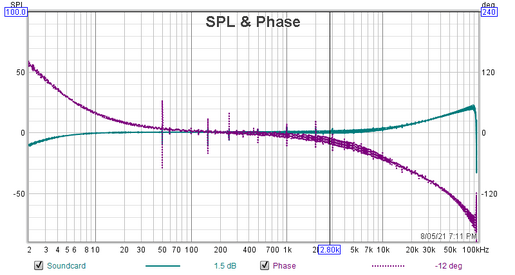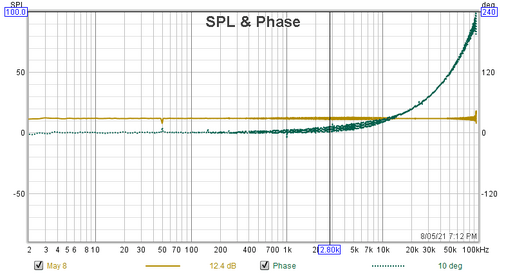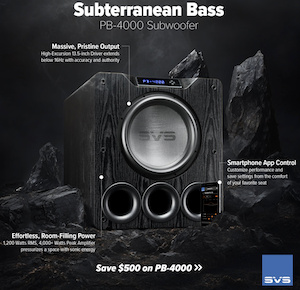I am trying to prepare a cal file that compensates a loopback configuration that includes a soundcard output to a balanced line driver and back to the soundcard input. The aim is to then use the balanced line driver to drive a DUT and connect the unbalanced DUT output to the soundcard input. The quirky aspect of this setup is that the DUT accepts a balanced input, so the balanced line driver output being used in the loopback is the centre-point of a matched set of resistors (and hence the input signal to the soundcard is quite a low level). The calibration process proceeds ok. When I measure the loopback response with the cal file now in use I do get a flat amplitude response from 2Hz to 96kHz, and I do get a flat phase response at the low frequency end (that compensates for the soundcard's input bandwidth of circa 10Hz) but the phase response at the high frequency end appears to curve up with nearly a mirror type response to the measurement without a cal (where phase shift smoothly reaches -180deg by about 90kHz). Inspection of the cal file shows phase values and polarities are what were recorded in the loopback measurement during the cal process, so it doesn't appear to be an issue related to the cal file data per se.
The only other note I can make is that the uncal'd amplitude response has a rising gain at high frequency (about +20dB at 90kHz), compared to a typical uncal'd loopback where the amplitude would typically fall off at the extreme frequency end.
Any comments on where I might have mucked up my process?
The measurement files are too large to attach, so I have attached screen grabs of raw loopback and loopback with cal.
(I am using a special REW version from 21 April 2021: REW_windows-x64_5_20_imp.exe)


The only other note I can make is that the uncal'd amplitude response has a rising gain at high frequency (about +20dB at 90kHz), compared to a typical uncal'd loopback where the amplitude would typically fall off at the extreme frequency end.
Any comments on where I might have mucked up my process?
The measurement files are too large to attach, so I have attached screen grabs of raw loopback and loopback with cal.
(I am using a special REW version from 21 April 2021: REW_windows-x64_5_20_imp.exe)














